For U8, please click here
For U10, please click here
Technical - Lofted Passing

In recent years, the long pass has received some unnecessary criticism. Watching teams like Barcelona and the current Man City team play a beautiful short passing game is a joy. But at the same time, so is watching goals like this one from Robin van Persie. As great as the finish is, the pass from Rooney is sublime. Perfectly weighted, with the right amount of back spin to slow the ball down mid-air and allow RvP the time to get there. Not to mention the fact that it take 2/3 defenders out of the game.
When players reach U12, players should be proficient using the inside and instep (laces) of their foot for basic striking techniques. It is our job as coaches to introduce more advanced techniques - swerving the ball, the chip and the lofted pass. The technique is a challenging one, as the manipulation of the players foot can take some getting used to. By U13, this becomes even harder as players battle puberty and massive growth spurts.
The lofted pass is a very beneficial technique when teaching teams and players to switch the field/point of attack. With U12 being the last season before players move on to 11 v 11, the size of the field at 9 v 9 has the right dimensions for players to achieve success in playing these cross field passes.
Game - Switch the Field SSG

Set up a field with a line of poles along the halfway line. Leave a gap between the end poles and the out of bounds/throw in line. Teams can only move the ball forward through the wide gaps. If the ball moves through the poles, the opposition get an indirect free kick.
Progression
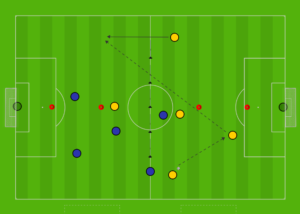
Use a line of cones to split the field into quarters. Teams can now move the ball forward over the poles with a lofted diagonal pass, from one quarter to the next. The ball must travel over the poles to count.
Why it Works
The set up of the game provides easy to see visual aids for a number of situations when switching the play is suitable. The poles add a realistic obstacle for players to clear with a lofted pass. Plenty of opportunities are available to play the lofted diagonal pass forward.
Tactical - Movement

Penetration, innovation, width and support. U12 players will have spent the past 6 years of their football development gradually increasing their understanding of these tactical principles. Intelligent movement is what allows these principles to shine in a game situation, dragging defenders out of position and exploiting the space created.
Passing patterns allow us to look at the advanced details of movement - the variation of speed & direction, as well as ensuring our players are aware of what is in front of them. We can give players the appropriate amount of repetition to ensure these good habits are highlighted in game related practices and small sided games.
Game - X Passing Pattern
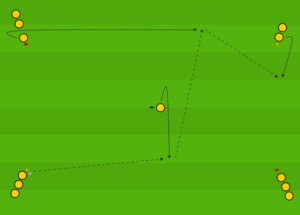
Set up 5 cones in an X formation. Use 3 different colours for players to follow (yellow, blue, red). Players are spread out at each of the cones, with 1 ball at the yellow cone. The yellow player passes to the blue player. The blue player receives on the turn, before playing a lead pass to the player at the red cone to run onto. The ball is then played into the next yellow cone. Players follow their pass and repeat the other way.
Progression
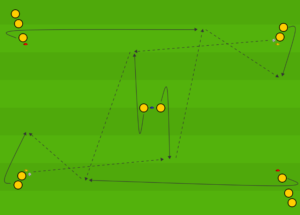
Introduce a second ball. If players get comfortable, attempt with 4 balls.
Why it Works
The practice works on 2 movements - towards the ball and the forward run. Players get plenty of repetition of making a double movement - away from the space and into it. Multiple balls increases the speed and thus the reaction. The run from the red cone must be timed so that players don't slow down.
Social - Avoiding the Clique

U12 is an awkward age for many. In the UK, children have started secondary school, which is a completely different environment to what they had at junior school. In the US, kids are entering the end of their middle school term (in selected states). Add this to the fact that some are already entering puberty and it's easy to see why children are described as "difficult". It's also easy to see why children at this age start forming groups with similiar minded individuals.
Cliques are a massive challenge that we as coaches face. We are not with the players at school or in their social lives, so there is only so much we can do. It is not uncommon to see players section off into their preferred school groups at practice. We have to face the fact that children become extremely internal as they approach/enter the teen years. Ajax described it as coaching a 5 year old with a well developed vocabulary. With this in mind, making sure that we run activities that allow players to mix and mesh are key.
Game - Possession Transition
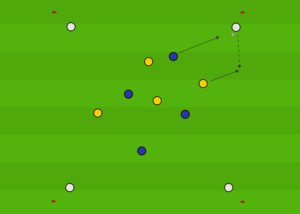
Make 3 teams of equal numbers. 2 teams work together to keep the ball away from the third team. If the defending team win the ball, the team that they won it off become the defending team.
Progression
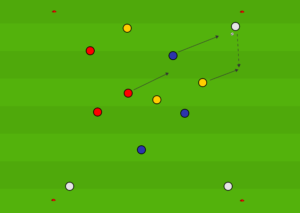
Make 4 equal teams. Coach calls out 2 colours (example "Yellow and White"). Those 2 colours work together to retain the ball from the other 2 teams. Coach can call 2 new clours out whenever he wants.
Why it Works
Players have to think and react quickly to a turnover in possession, or to the coach changing the environment. The constant changes of teams working together encourages the players to work together and rely on a variety of team mates.
Physical - Heading & Chest Control
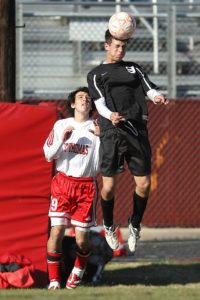
A growth spurt can lead to a lot of new found confidence. For me, it was slide tackling (long legs) and heading, as no one could out-jump me. A lot of this was to do with the fact that the ball was coming from a closer height and this is similar to most youth players. U12 is the perfect age to introduce chest control and heading into practices for these reasons.
It should be noted that practices should be monitored carefully. In the US, U12's are limited to 30 minutes of heading practice per week. Though tests are still being done regarding the impact of heading the ball at such a young age, collisions between 2 players are very much a possibility. An exceptionally talented player I worked with in North Carolina, who was in line for a scholarship with UNC Chapel Hill (coached by former Women's World Cup winner Anson Dorrance) had to quit the game completely because of consecutive concussions. We also saw Cristoph Kramer asking the ref "is this final?" after suffering head trauma in the 2014 World Cup Final.
Game - Throw Head Catch
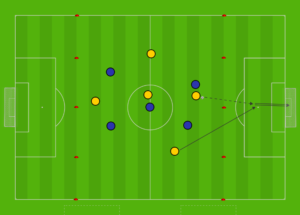
2 Teams, with scoring zones. The ball starts in a players hands. The ball is to be thrown like a throw in. The team mate thrown to, must head the ball on (unopposed), to be caught by the next player (this can be intercepted by the opponents). If thrown into the scoring zone, the player running in has a free header at goal.
Progression
Players are to chest and volley in the scoring zone. Players can also be challenged on the headers with careful supervision.
Why it Works
Players get to work on both types of header - defensive and offensive. The unopposed nature of the game ensures that head collisions are kept to a minimum. Players get to time their runs to be the offside line. Throw-in technique is gets a lot of repetition.

